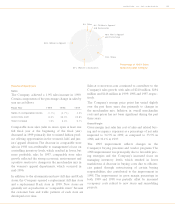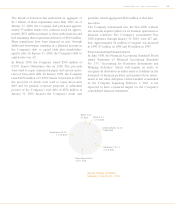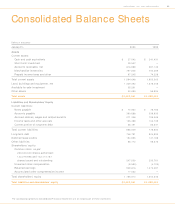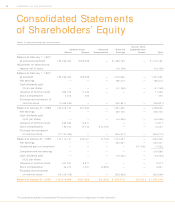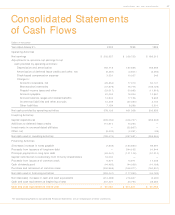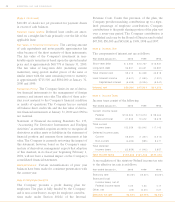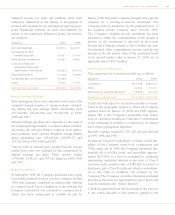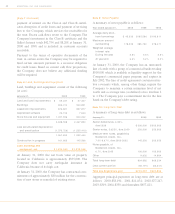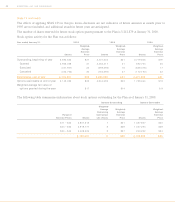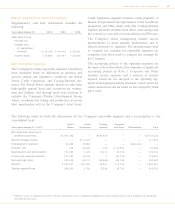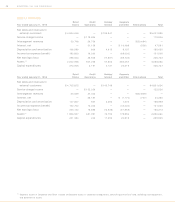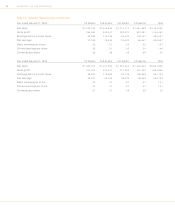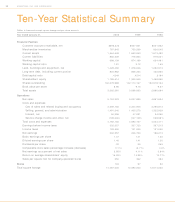Nordstrom 1999 Annual Report Download - page 43
Download and view the complete annual report
Please find page 43 of the 1999 Nordstrom annual report below. You can navigate through the pages in the report by either clicking on the pages listed below, or by using the keyword search tool below to find specific information within the annual report.
41NORDSTROM, INC. AND SUBSIDIARIES
Deferred income tax assets and liabilities result from
temporary differences in the timing of recognition of
revenue and expenses for tax and financial reporting pur-
poses. Significant deferred tax assets and liabilities, by
nature of the temporary differences giving rise thereto,
are as follows:
January 31, 2000 1999
Accrued expenses $ 29,276 $ 30,071
Compensation and
benefits accruals 35,651 30,404
Merchandise inventories 24,461 18,801
Land, buildings and
equipment basis and
depreciation differences (22,982) (34,519)
Employee benefits (11,008) (10,659)
Unrealized gain on investment (10,889) —
Other 12,570 11,011
Net deferred tax assets $57,079 $45,109
Note 5: Earnings Per Share
Basic earnings per share are computed on the basis of the
weighted average number of common shares outstand-
ing during the year. Average shares outstanding were
137,814,589, 146,241,091 and 154,972,560 in 1999,
1998 and 1997.
Diluted earnings per share are computed on the basis of
the weighted average number of common shares outstand-
ing during the year plus dilutive common stock equiva-
lents (primarily stock options). Weighted average diluted
shares outstanding were 138,424,844, 146,858,271 and
155,350,296 in 1999, 1998 and 1997.
Options with an exercise price greater than the average
market price were not included in the computation of
diluted earnings per share. These options totaled
2,798,966, 1,146,113 and 303,622 shares in 1999, 1998
and 1997.
Note 6: Investment
In September 1998, the Company purchased non-voting
convertible preferred stock in a private company. In June
1999, this company completed an initial public offering
of common stock. Upon completion of the offering, the
Company’s investment was converted to common stock,
which has been categorized as available-for-sale. In
January 2000, this public company merged with a private
company in a pooling-of-interests transaction. The
Company had an investment in the preferred stock of
the acquired private company since O ctober 1998.
The Company’s available-for-sale investment has been
increased to reflect the consummation of the merger. A
portion of the investment is reported as short-term
because the Company intends to sell it within one year.
Accumulated other comprehensive income includes the
increase in the fair market value of the investment based
on its quoted market value at January 31, 2000, net of
applicable taxes of $10.9 million.
Note 7: Accounts Receivable
The components of accounts receivable are as follows:
January 31, 2000 1999
Customers $611,858 $592,204
Other 20,969 19,474
Allowance for doubtful accounts (15,838) (24,543)
Accounts receivable, net $ 616,989 $5 87,135
Credit risk with respect to accounts receivable is concen-
trated in the geographic regions in which the Company
operates stores. At January 31, 2000 and 1999, approxi-
mately 38% of the Company’s receivables were obliga-
tions of customers residing in California. Concentration
of the remaining receivables is considered to be limited
due to their geographical dispersion.
Bad debt expense totaled $11,707, $23,828 and $40,440
in 1999, 1998 and 1997.
Nordstrom National Credit Bank, a wholly owned sub-
sidiary of the Company, issues both a proprietary and
VISA credit card. In 1996, the Company transferred sub-
stantially all of its VISA credit card receivables (approxi-
mately $203,000) to a trust in exchange for certificates
representing undivided interests in the trust. A Class A
certificate with a market value of $186,600 was sold to a
third party, and a Class B certificate, which is subordinat-
ed to the Class A certificate, was retained by the
Company. The Company owns the remaining undivided
interests in the trust not represented by the Class A and
Class B certificates (the “Seller’s Interest”).
Cash flows generated from the receivables in the trust are,
to the extent allocable to the investors, applied to the


